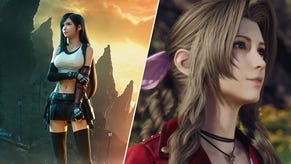Final Fantasy 7 Rebirth review: Ambitious, joyous, and bursting with an energy FF hasn’t had since the 90s
For better and worse alike, Final Fantasy 7 Rebirth is the most impressively ambitious game Square has made since FF’s golden age. It’s glorious, in spite of painful little flaws.
In the original Final Fantasy 7, a beloved character dies in the most brutal of ways. Half an hour later, you’re snowboarding.
That dichotomy has always been at the heart of FF7’s status as one of the most important games of all time. It’s also something that the developers at Square Enix have struggled to replicate over the years. Part of it is, I suspect, down to a free-flowing development that simply wouldn’t fly today. Experimenting with 3D for the first time, FF7’s staff just made stuff. Many of these creations were then stitched into the game’s narrative. This is perhaps best exemplified by how a story scene attached to the snowboarding event has unused dialogue coded in for the recently-deceased character. That was how development was; whoever initially wrote and programmed that scene likely didn’t even initially know where in the narrative the scene would fit.
Here’s the best possible news I can give you about Final Fantasy 7 Rebirth: it is the first Final Fantasy since that PS1 era to truly embody that spirit. While undoubtedly every single thing in it went through endless layers of pre-production and approval as things do in modern game development, the vibe the game has is one of a production where if somebody had a cool idea, it went in. Just like the good old days.
Structurally, Rebirth is actually remarkably similar to 2020’s FF7 Remake - though it’s also markedly different. Like Remake, its structural bones are the spirals, climbs, and plunges of a rollercoaster. It flies the player through entirely linear action stages that progress the story at great speed before pumping the brakes hard, letting you smell the roses in open-ended, sidequest-laden chapters. The former levels remain fairly familiar - but the latter have seen big changes.
The linear stages are pretty much identical to Remake. That’s for good and for ill. Rebirth features a much larger party of playable characters who are together in one great big gang all at once, for instance - but each time there’s a linear dungeon stage, the narrative finds a way to split the group, creating defined parties with a set composition. That allows the developers to craft combat encounters to challenge a specific set of character skills and abilities.
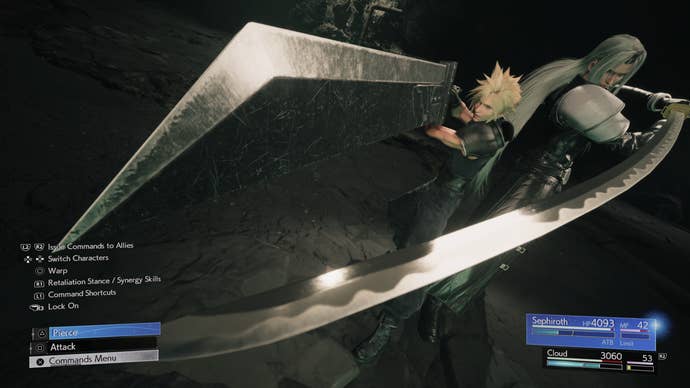
Whatever the story contrivances to split the group, it’s always worth it. Every character gets a little chance to shine in these combat scenarios. Never really using Cait Sith? Well now he’s party leader, with Barret and Aerith as backup. Meanwhile, Cloud, Tifa, and Yuffie are off on an all-brawling adventure of their own. At another point, Red XIII takes the reins, joined by Barret only. Dungeons and combat encounters are built to maximize the party’s compositional setup and occasionally to pack a narrative punch. Party members are deftly moved about like chess pieces, the developers always several steps ahead. The result is always thrilling.
With that said, let’s be clear: this game is not where you’ll go for inspiring dungeon design. These linear stages are about the character banter, the story progression, and amazing encounter design. Like Remake, the dungeons are generally one-way corridors - slightly wider open this time, admittedly - with no real deviance or choice. Maybe you duck slightly off the beaten path to grab a chest on a dead end you can see on the map. But really, you’re here to be funneled from one stirring fight to the next - and that’s fine. Slightly improved for this game, as in Remake’s ‘Episode Intermission’ DLC, is more to do in dungeons beyond fighting, like using grappling hooks to swing from point to point, pulling and latching chain-based door mechanisms, or throwing boxes at switches to open and close passageways. Ultimately, each dungeon is elevated by god-tier encounter design and a battle system that absolutely slaps.
When Rebirth slows down, it differentiates itself from Remake entirely. Where Remake had ‘open zones’ that were basically blobs of town and fight arenas connected by narrow corridors with plenty of load-hiding squeeze gaps, Rebirth has full-blown open world zones - each visually distinct and packed with optional activities for the player.
We’ve come a long way since 2010, when some of the same developers behind this game said it was too ‘hard’ to create towns in HD. Rebirth’s open world zones are defined by their luscious, labyrinthine population centers. Two of these are so large they have their own internal fast travel mechanics. Many actually feel bigger than they felt in FF7, which was magnificent at selling a sense of scale. The towns are a resounding success - and so too is the open world itself, though with some caveats.
There’s essentially six zones. Grasslands is a traditional resplendent nature area, and features the town of Kalm. The Junon area is mountainous, and features a fortress city of the same name carved into its mountainside. The Corel region is the busiest, home to both the ruined town of the same name, plus the dual paradises of the Gold Saucer and Costa Del Sol. The Gongaga Region is filled with fantasy fauna and features a small town of the same name, while the red deserts of Cosmo Canyon are of course home to that famous town. Finally, the Nibel Region plays host to Cloud and Tifa’s hometown of Nibelheim. A seventh zone unlocks late - and is basically an open ocean that connects the four zones, with a handful of things to do in it.
As early as the Grasslands area, I quickly zeroed in on what Rebirth’s discrete open zones most reminded me of - Dragon Age Inquisition. BioWare’s 2014 title is absolutely the open world Rebirth represents most in these sections. Grasslands is this game’s Hinterlands - where in a glorious initial showcase the developers lay out their wares. Ten hours later, you can still be muddling around that first zone, two chapters in, having barely progressed the story.
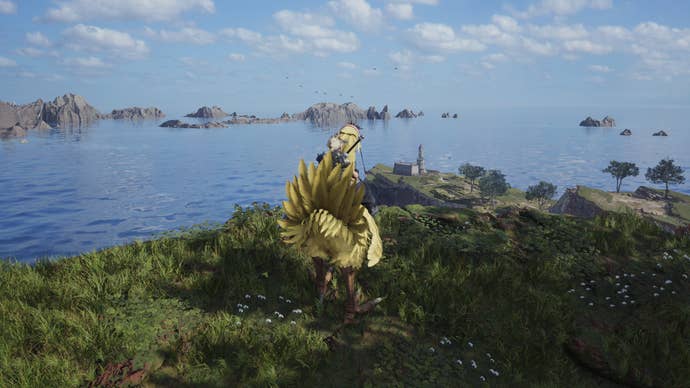
The tasks offered in the open world zones are generally good - but I found they began to wear a bit thin as I progressed from zone to zone. I want to be completely clear here - so here, in a basic list, is what you can expect in each of the six zones:
- Four to six towers to climb and activate, which reveals other activities on the map. You can stumble across activities without towers, however.
- Four to six Combat Assignments, which ask you to beat a certain combat scenario. Each one has three optional objectives to encourage you to beat them in a specific way, and they can be re-challenged. These are followed by a ‘Classified’ Fiend, a big optional boss, one per area.
- Three Summon Crystals, where you have to complete a basic memory ‘Simon says’ style puzzle. Each zone’s crystals makes a specific summon easier to unlock and more powerful once unlocked.
- Four Lifesprings, deposits of lifestream energy you have to scan. The scanning mini game is the same QTE every time, but scanning them unlocks one or two excavation sites, where you can scent out and dig up treasure with a Chocobo.
- Two to four Treasure Cache sites, where you can find and open a selection of hidden chests for basic loot.
- Four Phenomenon Intel, which are part of one mission strand that wraps up in the endgame. This is unique - each region has four of these challenges, but they differ in each zone. Junon’s four missions are ‘Fort Condor’ battles, using a tweaked version of the mini game that appeared in Remake’s DLC. Cosmo Canyon’s version is four missions of an all-new real-time strategy mini game. In the Grasslands, it’s four unique combat encounters with some additional mechanics like stealth leading up to them - and so on.
- Chocobo Unlocks, where you’ll have to complete a short mini-game to actually catch a Chocobo you can use in the area. One zone skips this.
- One Designated Photography Spot, which you must visit and use Photo Mode at to complete a recurring quest for a travelling Photographer NPC.
- Card Game Challenges, with each region playing host to a handful of card players you need to beat in Queen’s Blood, Rebirth’s new card game, to progress that storyline.
- Up to five side quests, each of which is ‘linked’ to a single party member. An Aerith quest will feature her as your companion in the quest’s cutscenes, for instance, and level up your affection and relationship with her on completion.
It’s great at first - but you can probably see from that list how, over time, it begins to grate. The problem is that the rewards for each of these activities are great, unlocking excellent character and RPG progression stuff or simply wonderful story beats with characters it’s impossible to not adore. But I’d be lying if I said by area three I wasn't getting a bit bored, and by area four and five I wasn't considering skipping huge chunks of it - and would actually advise other players to do so.
The tasks alone wouldn’t be so bad - but some of the mid-to-late game areas are too clever in their design for their own good. There’s bundles of verticality, but the map isn’t very clear at explaining vertical position - and so you can be looking at an icon on a map confused, unclear on exactly how to get there. Gongaga is built around bouncing off mushrooms on your Chocobo, and I must’ve spent over an hour just muddling around trying to navigate towards activities I’d yet to complete amidst extreme visual unreadability. Cosmo has a similar mechanic with Chocobo gliding, but it’s better executed and therefore less offensive; I do not exaggerate when I say Gongaga in particular is one of the worst open-world zones for navigation I’ve ever experienced. Combine this with the fact I was doing many of these same tasks for the fourth area running and you can see why patience will wear thin; this perhaps isn’t a game to 100%.
I say all this, and yet I can’t deny: much of the open world stuff nevertheless engrossed me. I hit a routine - I’d clear out the core story stuff until the open worlds were available, and then even though this game has one of the best soundtracks of all time I’d mute it, pop on a podcast, and mop up the non-sidequest content in a zoned-out state. Volume back on for the cutscene rewards for each task, and for the character-driven sidequests. For much of the game, I had a good time this way.
A lot of it is about scale, though - did there need to be as many of the same tasks as there are in each area? Especially in the case of Lifesprings, which are identical in each area? Rebirth’s developers proudly boast that it’s a 100-hour game (which tracks with my final runtime on my near-100% save) - but I reckon you could easily cut out at least 25% of the open world fluff here, slice a chunk off the runtime, and have a better game for it. Sometimes less is more.
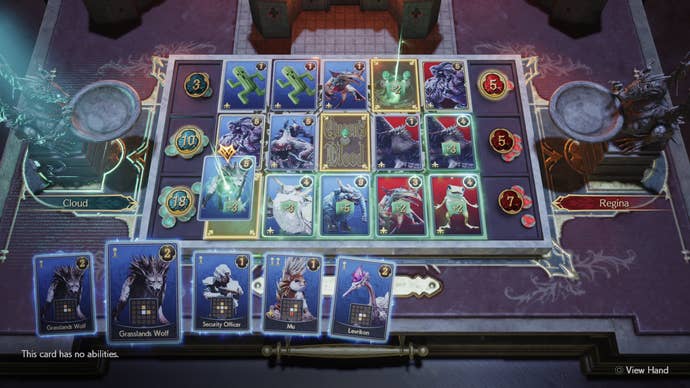
That’s not always true, though. Sometimes… more is more. That’s the approach the developers have taken with FF7 Rebirth’s mini games - which is to say, there’s a lot of them. The original FF7 is well-known for its mini games - but Rebirth takes that and dials it up to eleven. They are everywhere. All of the ones fans will remember from the nineties are present - but then also, a lot more besides. Sometimes these crop up as parts of side quests, or as quick interludes in the main narrative. Sometimes they’re just hidden off the beaten path, sometimes they’re in your face. Often, I wished some of the samey open world activities had been switched out for more uses of these mini games.
Like I said before, it’s here where the energy of Rebirth feels most like the original game. You can practically hear the development discussions that, in a reductive way, must’ve gone something like this: “With these assets, in this engine, we can make a Rocket League knock-off where Red XIII faces off against dogs.” And a director would say, “make it, ship it, great.” When somebody suggested Rebirth included ‘Fall Guys from Wish’, starring frogs, somebody waved it through. Put it in the game. Attach it to a side quest. Good. Why not? It’s joyful.
That joyful bent thrives throughout the narrative, too. These are iconic characters, but the narrative is never afraid to just have a little fun with them. It means narrative whiplash is pretty common, but this is the exact game and set of characters you can do this with - because that is precisely how they originated.
So, yes, a gut-wrenching emotional scene that moved me close to tears is indeed followed by a creative and ridiculous boss battle against a comic relief villain - and that’s okay. It feels right. Often the music does extremely heavy lifting in selling and softening these transitions that might otherwise be cognitively dizzying. The result is a thoughtful, masterfully curated soundtrack that is one of the best in video game history - simultaneously deeply respectful to Nobuo Uematsu’s original work and in this second game far more confident in exploring and establishing all-new themes. It’s a masterwork, as is all of the audio, from the brilliant voice performances on-down - though that work is sometimes let down by a surprisingly poor sound mix in places.
The investment the developers and writers have made in these characters not just in this game but in every FF7-related development since 1997 is proudly on show. Rebirth seeks to clarify and retcon some things, too - perhaps in some ways that might make some ‘shippers’ or lore purists mad - but it does so with a deft hand and respectful execution. There’s also brilliant new lenses these characters are examined through. Yuffie, barely present in the original game as an optional character, steals the show. She’s not simply that ‘bubbly young girl’ archetype, though she undoubtedly sits at the same lunch table as the likes of FF8’s Selphie, FF15’s Iris, or even FF9’s Eiko - but she’s more. And cleverly, she’s quickly paired off with Barret.
I want to use this as an example of the sort of storytelling FF7 Rebirth is best at, but it’s just one of my favorite instances in a game replete with similar examples. Yuffie and Barret rib each other in that sassy teen vs grizzled older geezer way, but it quickly becomes apparent that they are simply two sides of the same coin. Barret is her mirror image: grizzled, brutalized, and angry on the exterior, but a teddy bear underneath. Yuffie appears as happy-go-lucky, silly, and self-interested - but every now and then, there’s a flash of the shattered and revenge-desperate young woman that lies beneath that outward appearance. This isn’t really explicitly stated for much of the game - you just get the sense of a kinship developing between them through a smattering of smaller moments. Then, eventually, as the character most responsible for their pain appears, you see the two coalesce, briefly. Yuffie quietly requests that Barret not exact his revenge without her also being present. It’s for them to do together. This is something that’ll not be paid off in full until the third game; but it’s a sublime piece of character writing and execution.
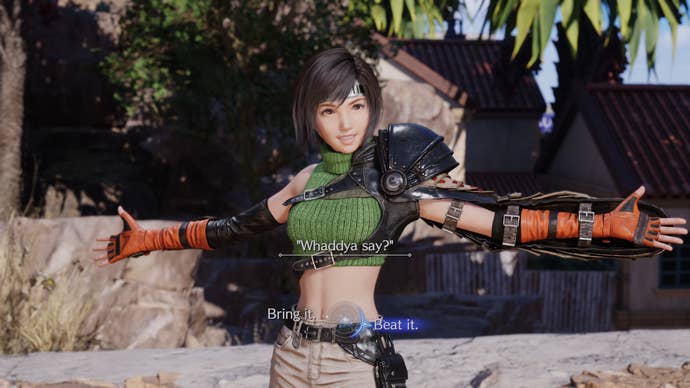
In fact, much emphasis is placed on pairings of characters in general. Cloud and Tifa’s relationship as childhood friends is examined more here than in the original game. Tifa and Aerith struggle to have a conversation that isn’t ultimately about Cloud or Zack, but they feel like real best friends in a way no other Final Fantasy duo has ever accomplished. This all bleeds into systems, too. As well as individual character EXP, a new ‘Party EXP’ stat represents the collective bonding of the group. This rises as you progress the main story and complete group-bonding side content. This unlocks bonuses for battle, including ‘Synergy Attacks’, where pairings of characters act together for flashy showcase moves. These are good looking, and have formed a tentpole in marketing, but they even have an impact on the ‘affection’ ratings with each character, which can determine who Cloud ends up going on a ‘date’ with in one of the most pivotal scenes in the game. I adore all of this.
I don’t adore everything this story does. While the character work and individual arcs are a masterclass, the core narrative is sort of an amorphous blob with no real structure. The story spins its wheels as nothing really happens - the characters just meander around the world following mute weirdos. Dialogue suggests the journey is urgent, with the fate of the planet at stake, but then you stop to hang out at the beach or play arcade games. The original FF7 featured all of this too, of course - but it was a small part of a much greater whole. In Rebirth, this narrative thread - if you can even call it that - makes up the whole game. This combines with the open world elements to mean that it’s a game that simultaneously has an incredible story but absolutely wild pacing problems.
As for the changes to the narrative - well, I won’t get into spoilers here, obviously. Suffice it to say I expect there’ll be autopsies on what it does to FF7’s story for years to come, until game three - but I do largely respect how it goes about doing those things. Everything is clearly handled with thought and care. At its worst, the game brings to mind the heart-in-the-right-place excesses of the Star Wars prequels. Did one of the most important macguffins in the FF7 world need a whole new detailed backstory added in this game? No, and I actually feel the story is better off without it - but the way in which that backstory is delivered is fascinating and quite artful.
My biggest gripe with the story is it stumbling into something I actually call ‘Star Wars Syndrome’, to keep that comparison going. It’s a pretty simple complaint: almost everybody remotely important from part one has also upped sticks and left Midgar - even the likes of Wall Market’s gym bros. This is deliberate, obviously, inviting the player to see someone they liked from the previous game - but constantly bumping into familiar faces even in minor roles does make the vast world of FF7 feel a bit small. Like I say, it reminds me of how, in Star Wars, the entire galaxy revolves around about ten people.

A crucial element of FF7 Remake and this game as its successor is that, well – it isn’t really a remake. It’s important to understand that. This is a game constantly aware of and in conversation with its originator and even its other spin-off media in a way that the likes of the Resident Evil remakes or Persona 3 Reload aren’t. This significantly changes the game; it flips the script.
Rebirth’s story has the whiff of one that wants to go further, but is too keen to please people - so it tries to keep multiple plates spinning. It wants to be an accurate and nostalgia-laden do-over of the original game, reference spin-off media that retconned the original game significantly, and also offer a thrilling new narrative and meta commentary on FF7’s legacy. Like Remake, it tries to accomplish this by for most of the game keeping things broadly similar with an occasional addition, intriguing new cutaway, or event reshuffles. Then in the final stretch it goes for it and swings for the fences. To be honest, I feel that’s a trick you can only play once - it doesn’t land as well for me here as it did in the first part. I left the game feeling like they needed to more decisively pick a lane rather than attempt to straddle multiple.
You see this a little mechanically, even. FF7 Rebirth is replete with new gameplay and character progression systems. It is the antidote to the barely-an-RPG fare of FF16. It feels like there’s about a hundred character things to sink your teeth into - weapon upgrades, folios, party level, character level, equipment, materia, synergy - there’s depth. Hard Mode, which is unlocked after finishing the game, is an absolute strategist's joy.
But this depth comes with curious repercussions. Equippable Materia, for instance, has been the absolute heart of every FF7 combat experience - but in Rebirth, Materia loadouts become more set-and-forget, as characters unlock alternatives through other means. There’s even skill-based magic elemental attacks that don’t cost MP now - so from early on, Cloud will have access to magic from all four elements regardless of what materia he has equipped. It all works, and Rebirth features an excellent evolution of the best-ever action combat in the Final Fantasy series (sorry, FF16) - though there is a subtle dilution and erosion of some of FF7’s mechanical identity here. Then again, one can see how the developers concluded that Remake’s pitch-perfect recreation of the original game’s systems would have struggled to shoulder another 100 hours of game - so they mixed it up. They add, add, add. If you love the Materia system, it’s there. Skill trees? Yep. Weapon upgrades? Of course. New mechanics? Gotcha. Throw it all in.

This is the theme of FF7 Rebirth: it tries to do absolutely everything and tries to please everyone. That means that there’s inevitably something here for absolutely everyone. Fans can enjoy a nostalgia trip and intriguing new developments. Newcomers and Remake fans can immerse themselves in one of the most charismatic worlds and casts in video game history for the first time, and probably be baffled by some of what’s going on. There’s loads to love, and it’s a truly magical experience.
But all that stuff also means that it’s the definition of a bloated game. I don’t mean that in that 2010s Ubisoft open world icon vomit way - this is a game with far more craft than that. It’s inevitable when you do so much that some things are going to struggle to land or mesh. The fact that this game is so expansive and as much of it works as it does actually feels a bit like a miracle on par with that of the wild success of the original FF7. Rebirth feels like a culmination of over two decades of work for a certain set of Square Enix developers - people whose careers track from the original FF7 through FF8, FF10, FF13, the aborted Versus turned FF15, and to Remake, and now this. Rebirth feels like the natural conclusion of that journey.
FF7 Rebirth is an astonishing piece of work. In the pantheon of the FF series, it stands arguably as the single most ambitious title Square has ever produced - except for the game whose legacy it is chasing, of course. Unchecked ambition makes this magical - but also undoubtedly makes it flawed in some key, prickly ways. I didn’t glide through this game in as frictionless a way as I did Remake, which was that rare game where I just completely lost myself in it, engrossed beyond belief. But it’s also fair to say that the vibes on Rebirth are superior - it’s a game with feeling, with heart, with joy in its excess. As you play, it frequently bequeaths that joy to you. And what else are video games for, if not to make you feel that way?
As with many of the dilemmas of FF7's characterful narrative, this review becomes a matter of the heart facing off with the head. Leveling my full critical faculties at this game, head-first, there’s much to address. My joy at the game’s best does not absolve it of these problems. Lessons for the third game are in obvious abundance. Flaws be damned, scores be damned, though. In my heart, this will inevitably end up as one of my favorite games of 2024 - its vibes are simply irresistible.
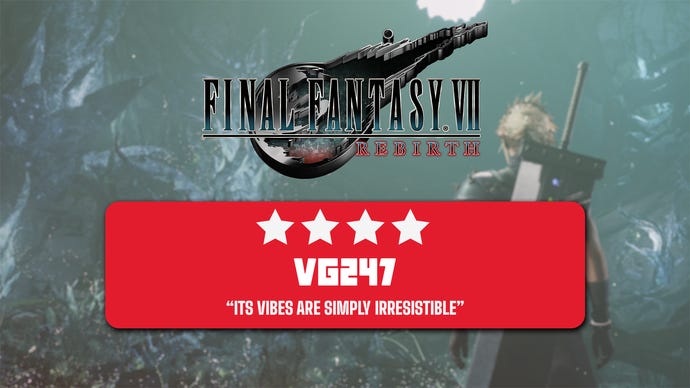

.jpg?width=291&height=164&fit=crop&quality=80&format=jpg&auto=webp)
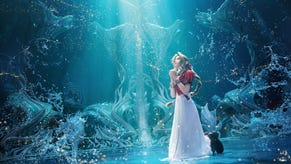
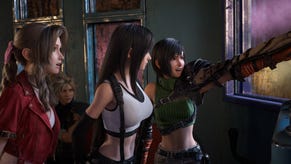
.png?width=291&height=164&fit=crop&quality=80&format=jpg&auto=webp)

.jpg?width=291&height=164&fit=crop&quality=80&format=jpg&auto=webp)
.jpg?width=291&height=164&fit=crop&quality=80&format=jpg&auto=webp)
